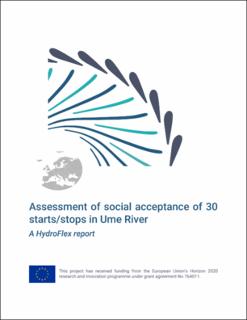| dc.description.abstract | The objective of this report is to assess the social acceptance of increased hydropower flexibility. Using a case study approach focusing on one of the HydroFlex reference sites, Stornorrfors power plant located in the Ume River in Sweden, we investigate how different user groups of the river perceive and engage with scenarios of increased flexibility, compared to the current operating regime of the power plant. Since Umeå city is located at the riverbank of Ume River, the human use of the river and riverbanks covers a wide range of activities. Based on interviews with stakeholders at Ume River during winter and spring 2020/2021 and a supplementary literature review, we assess and map reasons for support and resistance for increased flexibility. This investigation includes scenarios with and without the mitigation technology ACUR (Air Cushion Underground Reservoir – a technology developed in the HydroFlex project), which minimizes the water fluctuations induced by flexible operation schemes. Our study showed that most stakeholders were generally positive towards hydropower and increasingly flexible operation schemes as enabler of the deployment of intermittent renewable energy and, thus, as contribution to the mitigation of climate change. In line with previous research, environmental impacts of hydropeaking were of major concern to the users of Ume älv. In addition, informants mentioned a range of practical concerns connected to their specific uses of the river, such as safety concerns related to ice crossing as well as erosion and landslides, access to facilities for recreational purposes and difficulties for boating and kayaking activities. Finally, informants experienced a lack of information from power plant owners and demanded better dialogue and participation in decision-making. We recommend that power producers and policy makers do the following to address public concerns and increase support for highly flexible operation of power plants:
• Recognition and inclusion of the diversity of relevant stakeholders, indigenous people and their concerns.
• Early and continuous involvement of stakeholders both with regard to the operation scheme of the power plant and with regard to mitigation and compensation measures. Those not interested/relevant can drop out.
• Establishment of a communication arena between NGOs/stakeholders and the power company and definition of a person from the power plant operator as responsible for public contact and outreach.
• Stronger focus on information to the public (signs), active use of media about reasons for more flexible operations of the power plant, information about water level changes (for safety reasons).
• Access to sites – power plant owners should actively engage with local organizations to make riverbanks and viewpoints an attractive tourism and recreation site.
• Follow existing environmental recommendations and standards and actively compensate the local community (e.g., infrastructure with local value, not necessarily money). | en_US |
